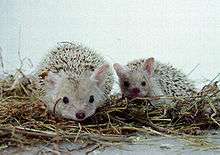Hedgehog
A hedgehog is any of the spiny mammals of the subfamily Erinaceinae, in the eulipotyphlan family Erinaceidae. There are seventeen species of hedgehog in five genera found through parts of Europe, Asia, and Africa, and in New Zealand by introduction. There are no hedgehogs native to Australia and no living species native to the Americas (the extinct genus Amphechinus was once present in North America).
| Hedgehogs[1] | |
|---|---|
| European hedgehog | |
| Scientific classification | |
| Kingdom: | Animalia |
| Phylum: | Chordata |
| Class: | Mammalia |
| Order: | Eulipotyphla |
| Family: | Erinaceidae |
| Subfamily: | Erinaceinae G. Fischer, 1814 |
| Genera | |
Hedgehogs share distant ancestry with shrews (family Soricidae), with gymnures possibly being the intermediate link, and they have changed little over the last 15 million years.[2] Like many of the first mammals, they have adapted to a nocturnal way of life.[3] Their spiny protection resembles that of the unrelated porcupines, which are rodents, and echidnas, a type of monotreme.
Etymology
The name hedgehog came into use around the year 1450, derived from the Middle English heyghoge, from heyg, hegge ("hedge"), because it frequents hedgerows, and hoge, hogge ("hog"), from its piglike snout.[4] Other names include urchin, hedgepig and furze-pig.
Physical description
Hedgehogs are easily recognized by their spines, which are hollow hairs made stiff with keratin.[5] Their spines are not poisonous or barbed and, unlike the quills of a porcupine, do not easily detach from their bodies. However, the immature animal's spines normally fall out as they are replaced with adult spines. This is called "quilling". Spines can also shed when the animal is diseased or under extreme stress. Hedgehogs are usually brown, with pale tips to the spines, though blonde hedgehogs are found on the UK island of Alderney.
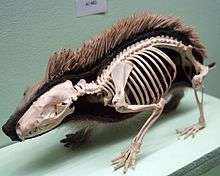
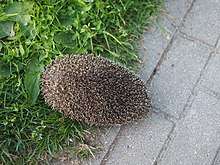
All species of hedgehogs can roll into a tight ball in self-defense, causing all of the spines to point outwards.[5] The hedgehog's back contains two large muscles that control the position of the quills. When the creature is rolled into a ball, the quills on the back protect the tucked face, feet, and belly, which are not quilled. Since the effectiveness of this strategy depends on the number of spines, some desert hedgehogs that evolved to carry less weight are more likely to flee or attack, ramming an intruder with the spines; rolling into a spiny ball for those species is a last resort. The various species are prey to different predators: while forest hedgehogs are prey primarily to birds (especially owls) and ferrets, smaller species like the long-eared hedgehog are prey to foxes, wolves, and mongooses.
Hedgehogs are primarily nocturnal, though some species can also be active during the day. Hedgehogs sleep for a large portion of the day under bushes, grasses, rocks, or most commonly in dens dug in the ground, with varying habits among the species. All wild hedgehogs can hibernate, though not all do, depending on temperature, species, and abundance of food.
Hedgehogs are fairly vocal and communicate through a combination of grunts, snuffles and/or squeals, depending on species.
Hedgehogs occasionally perform a ritual called anointing.[6] When the animal encounters a new scent, it will lick and bite the source, then form a scented froth in its mouth and paste it on its spines with its tongue. The purpose of this habit is unknown, but some experts believe anointing camouflages the hedgehog with the new scent of the area and provides a possible poison or source of infection to predators poked by their spines. Anointing is sometimes also called anting because of a similar behavior in birds.
Like opossums, mice, and moles, hedgehogs have some natural immunity against some snake venom through the protein erinacin in the animal's muscular system, although it is available only in small amounts and a viper bite may still be fatal.[7] In addition, hedgehogs are one of four known mammalian groups with mutations that protect against another snake venom, α-neurotoxin. Pigs, honey badgers, mongooses, and hedgehogs all have mutations in the nicotinic acetylcholine receptor that prevent the snake venom α-neurotoxin from binding, though those mutations developed separately and independently.[8]
Olfactory sense
The olfactory regions have not been thoroughly studied in the hedgehog. In mammals, the olfactory part of the brain is covered by neopallium, making it difficult to expose. This difficulty is not insurmountable, as it varies from one species to another. Tests have suggested that hedgehogs share the same electrical activity as cats.[9]
Diet
Although traditionally classified in the now abandoned order Insectivora, hedgehogs are omnivorous. They feed on insects, snails, frogs and toads, snakes, bird eggs, carrion, mushrooms, grass roots, berries, melons and watermelons.[5] Berries constitute a major part of an Afghan hedgehog's diet in early spring after hibernation.
Hibernation
During hibernation, the body temperature of a hedgehog can decrease to about 2 °C (36 °F). When the animal awakes from hibernation, the body temperature rises from 2–5 °C (36–41 °F) back to its normal 30–35 °C (86–95 °F) body temperature.[10]
Reproduction and lifespan
Depending on the species, the gestation period is 35–58 days. The average litter is 3–4 newborns for larger species and 5–6 for smaller ones. As with many animals, it is not unusual for an adult male hedgehog to kill newborn males.
Hedgehogs have a relatively long lifespan for their size. Larger species of hedgehogs live 4–7 years in the wild (some have been recorded up to 16 years), and smaller species live 2–4 years (4–7 in captivity), compared to a mouse at 2 years and a large rat at 3–5 years. Lack of predators and controlled diet contribute to a longer lifespan in captivity (8–10 years depending on size).
Hedgehogs are born blind with a protective membrane covering their quills, which dries and shrinks over the next several hours.[11] The quills emerge through the skin after they have been cleaned, or it falls off.[12]
Predators
Hedgehog bones have been found in the pellets of the European eagle owl.[13]
In Britain, the main predator is the badger. European hedgehog populations in the United Kingdom are lower in areas where badgers are numerous,[14] and British hedgehog rescue societies will not release hedgehogs into known badger territories.[15] Badgers also compete with hedgehogs for food.[16]
Domestication
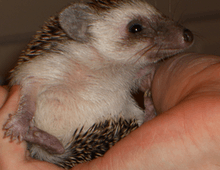
The most common pet species of hedgehog are hybrids of the white-bellied hedgehog or four-toed hedgehog (Atelerix albiventris) and the North African hedgehog (A. algirus).[17] It is smaller than the European hedgehog, and thus is sometimes called the African pygmy hedgehog. Other species kept as pets are the long-eared hedgehog (Hemiechinus auritus) and the Indian long-eared hedgehog (H. collaris).
It is illegal to own a hedgehog as a pet in some US states including Hawaii, Georgia, Pennsylvania, and California,[18] and some Canadian municipalities, and breeding licenses are required. No such restrictions exist in most European countries with the exception of Scandinavia. In Italy, it is illegal to keep wild hedgehogs as pets.[19]
Invasive species
In areas where hedgehogs have been introduced, such as New Zealand and the islands of Scotland, the hedgehog has become a pest. In New Zealand it causes immense damage to native species including insects, snails, lizards and ground-nesting birds, particularly shore birds.[20] As with many introduced animals, it lacks natural predators.
Eradication can be troublesome. Attempts to eliminate hedgehogs from bird colonies on the Scottish islands of North Uist and Benbecula in the Outer Hebrides were met with international outrage. Eradication began in 2003 with 690 hedgehogs being killed. Animal welfare groups attempted rescues to save the hedgehogs. By 2007, legal injunctions against the killing of hedgehogs were put in place. In 2008, the elimination process was changed from killing the hedgehogs to trapping them and releasing them on the mainland.[21]
Diseases
Hedgehogs suffer many diseases common to humans.[22] These include cancer, fatty liver disease and cardiovascular disease.
Cancer is very common in hedgehogs. The most common is squamous cell carcinoma. Squamous cell spreads quickly from the bone to the organs in hedgehogs, unlike in humans. Surgery to remove the tumors is rare because it would result in removing too much bone structure.
Fatty liver disease is believed by many to be caused by bad diet. Hedgehogs will eagerly eat foods that are high in fat and sugar. Having a metabolism adapted for low-fat, protein-rich insects, this leads to common problems of obesity. Fatty liver disease is one sign, heart disease is another.
Hedgehogs uncommonly transmit a characteristic fungal skin infection to human handlers as well as other hedgehogs. This ringworm or dermatophytosis infection is caused by Trichophyton erinacei, which forms a distinct mating group within the Arthroderma benhamiae species complex.[23]
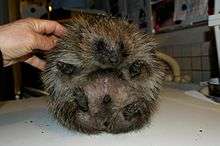
Hedgehogs can suffer from balloon syndrome, a rare condition in which gas is trapped under the skin as a result of injury or infection and which causes the animal to inflate; in 2017 the BBC reported a case in which a male hedgehog was "almost twice its natural size, literally blown up like a beach ball with incredibly taut skin".[24] The head vet at Stapeley's Wildlife Hospital, Bev Panto, said, "In my career I have seen three or four of these cases and they are very strange every time and quite shocking ... When you first see them they appear to be very big hedgehogs but when you pick them up they feel so light because they are mostly air".[25] She added that the condition was unique to hedgehogs because they have significant space under their skin as a result of their ability to curl up.[25] A similar case had been reported in 2013.[26] The British Hedgehog Preservation Society advises that:
There is no single cause for this condition. The air can be removed by incising or aspirating through the skin over the back. Antibiotic cover should be given. This may be associated with lung/chest wall damage or a small external wound acting like a valve or a clostridium type infection.[27]
Human influence

As with most small mammals living around humans, cars pose a great threat to hedgehogs. Many are run over as they attempt to cross roadways. In Ireland, hedgehogs are one of the most common mammalian road fatalities. Between April 2008 and November 2010 on two stretches of road measuring 227 km and 32.5 km there were 133 recorded hedgehog fatalities. Of another 135 hedgehog carcasses collected from throughout Ireland, there were significantly more males than females collected, with peaks in male deaths occurring in May and June. Female deaths outnumbered males only in August, with further peaks in female deaths observed in June and July. It is suggested that these peaks are related to the breeding season (adults) and dispersal/exploration following independence.[28]
Domesticated hedgehogs can get their heads stuck in tubes (commonly, toilet paper tubes) and walk around with them on their heads. Owners often refer to this as "tubing" and promote the behavior by supplying lean tubes. Most owners are considerate enough, however, to cut the tubes lengthwise to prevent the hedgehog from remaining trapped against its will. Curiously, some hedgehogs still knowingly get themselves stuck for hours.[29]
Culinary and medicinal use
Hedgehogs are a food source in many cultures. Hedgehogs were eaten in Ancient Egypt and some recipes of the Late Middle Ages call for hedgehog meat.[30] Hedgehogs are traded throughout Eurasia and Africa for traditional medicine and witchcraft. In the Middle East and especially among Bedouins, hedgehog meat is considered medicinal, and thought to cure rheumatism and arthritis.[31] They are also said to cure a variety of illnesses and disorders from tuberculosis to impotence. In Morocco, inhaling the smoke of the burnt skin or bristles is a purported remedy for fever, male impotence, and urinary illnesses. The blood is sold as a cure for ringworm, cracked skin and warts and the flesh is eaten as a remedy for witchcraft.[32] Romani people still eat hedgehogs, boiled or roasted, and also use the blood and the fat for its supposed medicinal value.[33]
In 1981 Welsh pub-owner Philip Lewis began the manufacture of "hedgehog-flavoured" crisps. Lewis's marketing had to change, however from hedgehog 'flavoured' to hedgehog 'flavour', due to advertising standards, as the crisps did not actually contain any hedgehog.[34]
In culture
- The classical Persians saw the hedgehog as sacred to Ahura Mazda because of its dedication to destroying agricultural pests: "the dog with the prickly back and the long, thin muzzle...from midnight to morning it kills thousands of the creatures of the Evil One".[35]
- The Ancient Greeks valued the saying of Archilochos: "The fox knows many tricks, the hedgehog, one good one" (presumably its ability to roll up in a ball).[36]
- An essay by Isaiah Berlin, The Hedgehog and the Fox, translates the Archilochos quotation as: "a fox knows many things, but a hedgehog one important thing". The essay distinguishes writers who see the world as complex and multi-faceted from those who see it via single over-arching idea.
- Sir Richard Onslow (1601–64), parliamentarian, compared King Charles I of England to a hedgehog.[37][38]
- The title character in Beatrix Potter's 1905 children's story The Tale of Mrs. Tiggy-Winkle is a hedgehog.[39]
- In Part Four of Fyodor Dostoyevsky's The Idiot, Aglaya gives Prince Myshkin a hedgehog that Kolya has acquired and sold to her, as a gift of reconciliation, which clears up the bad feeling between them after a quarrel. In the passage, the hedgehog is identified as signifying "friendship, a burying of the hatchet, and making up".[40]
- E. Nesbit wrote a fantasy short story entitled "The Princess and the Hedge-pig" (collected in The Magic World, 1912), in which a prince is under an enchantment, and his transformation into a hedgehog allows a curious prophecy to come true.
- In the 1927 British detective novel, The Ellerby Case by John Rhode, in the chapter entitled "The Green Hedgehog," Doctor Lancelot Priestly, the investigator who solves the case, is nearly murdered by a hedgehog dyed green whose spines have been impregnated with a virulent poison.
- Philip Larkin, the well-known twentieth century poet, wrote one of his last poems on the death of a hedgehog, "The Mower".[41]
- Sonic the Hedgehog, first introduced in 1991, is a blue anthropomorphic hedgehog and the title character of numerous video games, comic strips, and animated cartoons by Sega.
- The novelist Jasper Fforde conceived of a Hedge-pigs Society, intended to "advance hedgehogs in all branches of literature....[which] got references into Kipling, Carroll, Aesop and four mentions in Shakespeare".[42]
- A speech in the British House of Commons about the hedgehog, by environment minister Rory Stewart, was named by two newspapers as the best speech of 2015.
Genera and species
Subfamily Erinaceinae (hedgehogs)[1]
- Genus Atelerix
- Four-toed hedgehog, Atelerix albiventris
- North African hedgehog, Atelerix algirus
- Southern African hedgehog, Atelerix frontalis
- Somali hedgehog, Atelerix sclateri
- Genus Erinaceus
- Amur hedgehog, Erinaceus amurensis
- Southern white-breasted hedgehog, Erinaceus concolor
- European hedgehog, Erinaceus europaeus
- Northern white-breasted hedgehog, Erinaceus roumanicus
- Genus Hemiechinus
- Long-eared hedgehog, Hemiechinus auritus
- Indian long-eared hedgehog, Hemiechinus collaris
- Genus Mesechinus
- Daurian hedgehog, Mesechinus dauuricus
- Hugh's hedgehog, Mesechinus hughi
- Gaoligong forest hedgehog, Mesechinus wangi
- Genus Paraechinus
- Desert hedgehog, Paraechinus aethiopicus
- Brandt's hedgehog, Paraechinus hypomelas
- Indian hedgehog, Paraechinus micropus
- Bare-bellied hedgehog, Paraechinus nudiventris
See also
- Echidnas or "spiny anteaters", members of the order Monotremata that have spines
- Hedgehog's dilemma
- Hedgehogs in culture
- Porcupines, two different rodent families which have spines or quills
- The Hedgehog and the Fox
References
- Hutterer, R. (2005). "Order Erinaceomorpha". In Wilson, D.E.; Reeder, D.M (eds.). Mammal Species of the World: A Taxonomic and Geographic Reference (3rd ed.). Johns Hopkins University Press. pp. 212–217. ISBN 978-0-8018-8221-0. OCLC 62265494.
- Reiter C, Gould GC (1998). "Thirteen Ways of Looking at a Hedgehog". Natural History. 107 (6): 52.
- "WildlifeTrust.org.uk". WildlifeTrust.org.uk. Archived from the original on 12 February 2013. Retrieved 28 February 2013.
- Oxford English Dictionary, Online edition. Retrieved 13 July 2007.
- Attenborough, David (2014). Attenborough's Natural Curiosities 2. Armoured Animals. UKTV.
- Drew, Lisa W. (1 June 2005). "Meet the Hedgehog: What feeds on lizards, chews venomous toad skins and coats its spiky body with frothy saliva?". National Wildlife. Reston, Virginia: National Wildlife Federation. Retrieved 12 July 2017.
- Omori-Satoha, Tamotsu; Yoshio Yamakawab; Dietrich Mebs (November 2000). "The antihemorrhagic factor, erinacin, from the European hedgehog (Erinaceus europaeus), a metalloprotease inhibitor of large molecular size possessing ficolin/opsonin P35 lectin domains". Toxicon. 38 (11): 1561–80. doi:10.1016/S0041-0101(00)00090-8. PMID 10775756.
- Drabeck, D.H.; Dean, A.M.; Jansa, S.A. (1 June 2015). "Why the honey badger don't care: Convergent evolution of venom-targeted nicotinic acetylcholine receptors in mammals that survive venomous snake bites". Toxicon. 99: 68–72. doi:10.1016/j.toxicon.2015.03.007. PMID 25796346.
- Adrian, E. D. (1942). "Olfactory reactions in the brain of the hedgehog". The Journal of Physiology. 100 (4): 459–473. doi:10.1113/jphysiol.1942.sp003955. PMC 1393326. PMID 16991539.
- Suomalainen, Paavo; Sarajas, Samuli (1 August 1951). "Heart-beat of the Hibernating Hedgehog". Nature. 168 (4266): 211. Bibcode:1951Natur.168..211S. doi:10.1038/168211b0. ISSN 0028-0836. PMID 14875055.
- Litter – Burlington and MIDI (04/19/2004) Archived 10 July 2009 at the Wayback Machine. hamorhollow.com
- "Babies & Reproduction". Hedghogz.co.uk. Archived from the original on 6 September 2013. Retrieved 8 March 2009.CS1 maint: BOT: original-url status unknown (link)
- Social Behaviour / Territoriality / Predation / Learning: West European Hedgehog. wildlifeinformation.org
- Hof, A. R.; Bright, P. W. (2010). "The value of agri-environment schemes for macro-invertebrate feeders: Hedgehogs on arable farms in Britain" (PDF). Animal Conservation. 13 (5): 467–473. doi:10.1111/j.1469-1795.2010.00359.x.
Badger predation of hedgehogs was high in the study site and the main cause of death
- Where have all the hedgehogs gone ?. Snufflelodge.org.uk. Retrieved 2013-09-05.
- David Wembridge. "The State of Britain's Hedgehogs 2011" (PDF). The British Hedgehog Preservation Society.
- "The Complete Guide to Hedgehogs". www.petmd.com. Retrieved 16 February 2020.
- "Hedgehogs are a prickly issue in some states". mnn.com.
- "Fauna selvativa e specie protette". Corpo Forestale dello Stato. Archived from the original on 2 November 2016. Retrieved 31 August 2014.
- "Hedgehogs pose prickly problem for native fauna". Landcare Research media release. 17 September 2003. Archived from the original on 1 October 2003. Retrieved 6 December 2011.
- Ross, David (14 January 2009). "18 Trappers Sought for Hebrides to Protect Birds from Hedgehogs". The Herald. Retrieved 12 June 2009.
- "List of Hedgehog diseases". Wildlifeinformation.org. Archived from the original on 26 July 2010. Retrieved 8 March 2009.
- Takahashi, Yoko; Ayako Sano; Kayoko Takizawa; Kazutaka Fukushima; Makoto Miyaji; Kazuko Nishimura (2003). "The epidemiology and mating behavior of Arthroderma benhamiae var. erinacei in household four-toed hedgehogs (Atelerix albiventris) in Japan" (PDF). Japanese Journal of Medical Mycology. 44 (1): 31–8. doi:10.3314/jjmm.44.31. PMID 12590257.
- "Hedgehog 'blown up like beach ball' has balloon syndrome". BBC News Online. BBC. 11 June 2017. Retrieved 11 June 2017.
- "Balloon syndrome hedgehog is 'popped'". BBC News Online. BBC. 12 June 2017. Retrieved 12 June 2017.
- "Inflated 'balloon' hedgehog saved from 'rupturing' by vet". BBC News Online. BBC. 22 May 2013. Retrieved 11 June 2017.
- Forshaw, Hugh. "' Care and Treatment of Sick and Injured Hedgehogs" (PDF). britishhedgehogs.org.uk. British Hedgehog Preservation Society. Retrieved 11 June 2017.
- Haigh, Amy; O'Riordan, Ruth M.; Butler, Fidelma (2014). "Hedgehog Erinaceus europaeus mortality on Irish roads". Wildlife Biology. 20 (3): 155–160. doi:10.2981/wlb.12126.
- "A community for African Pygmy Hedgehog Owners and Breeders – Environmental Enrichment". Hedgehog World. Archived from the original on 15 January 2008. Retrieved 8 March 2009.
- Pidd, Helen (14 September 2007). "Roast hedgehog and nettle pud – a slap-up feast for ancient Britons". The Guardian. London. Retrieved 12 June 2009.
- Qumsiyeh, Mazin B. (1996). Mammals of the Holy Land. Texas Tech UP. p. 64. ISBN 978-0-89672-364-1.
- Nijman, V.; Bergin, D. (2015). "Trade in hedgehogs (Mammalia: Erinaceidae) in Morocco, with an overview of their trade for medicinal purposes throughout Africa and Eurasia". Journal of Threatened Taxa. 7 (5): 7131–7137. doi:10.11609/JoTT.o4271.7131-7.
- Wood, Manfri Frederick (1979). In the Life of a Romany Gypsy. J.A. Brune. pp. 80–81. ISBN 978-0-7100-0197-9.
- "Potato Crisps – A History". BBC. 7 December 2002. Retrieved 22 March 2010.
- Vendidad in A R Burn, Persia and the Greeks (Stanford 1984) p. 67
- A R Burn, Persia and the Greeks (Stanford 1984) p. 353
- Dictionary of National Biography, Vol. XLII, 1895
- Henning, B.D., ed. (1983). "ONSLOW, Sir Richard (1601–64), of West Clandon, Surr. and Arundell House, The Strand, Westminster". The History of Parliament: the House of Commons 1660–1690. Boydell and Brewer.
- "The Tale of Mrs. Tiggy-Winkle by Beatrix Potter". www.penguin.co.uk. Retrieved 15 January 2017.
- Dostoevsky, Fyodor. The Idiot (Oxford World's Classics) (p. 538). OUP Oxford. Kindle Edition.
- Laville, Sandra (11 May 2002). "Larkin's lawnmower cuts it as a relic". The Daily Telegraph. London. Retrieved 11 June 2017.
- J Fforde, The Well of Lost Plots (London 2004) p. 57
External links
| Look up hedgehog in Wiktionary, the free dictionary. |
| Wikimedia Commons has media related to Erinaceinae. |
